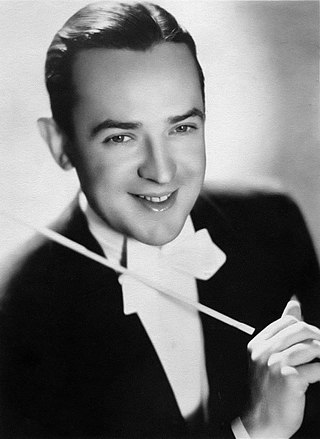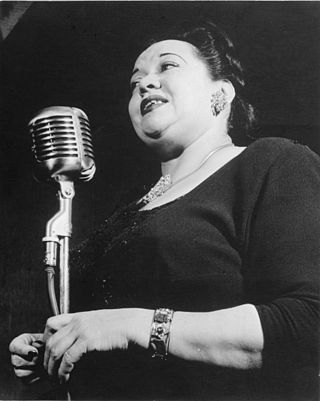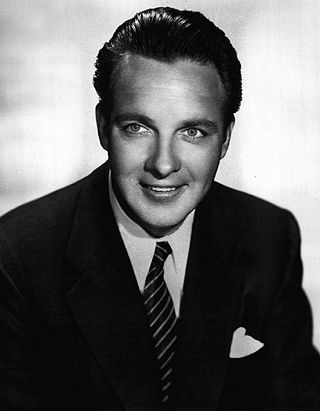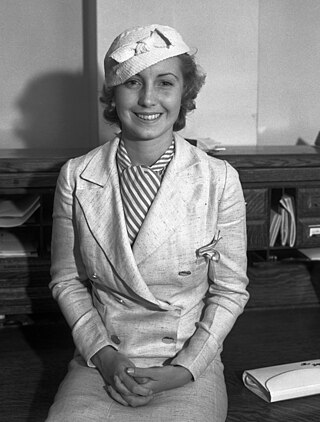
Benjamin David Goodman was an American clarinetist and bandleader, known as the "King of Swing".
Swing music is a style of jazz that developed in the United States during the late 1920s and early 1930s. It became nationally popular from the mid-1930s. Swing bands usually featured soloists who would improvise on the melody over the arrangement. The danceable swing style of big bands and bandleaders such as Benny Goodman was the dominant form of American popular music from 1935 to 1946, known as the swing era, when people were dancing the Lindy Hop. The verb "to swing" is also used as a term of praise for playing that has a strong groove or drive. Musicians of the swing era include Duke Ellington, Benny Goodman, Count Basie, Cab Calloway, Benny Carter, Jimmy Dorsey, Tommy Dorsey, Woody Herman, Earl Hines, Bunny Berigan, Harry James, Lionel Hampton, Glenn Miller, Artie Shaw, Jimmie Lunceford, and Django Reinhardt.

James Francis Dorsey was an American jazz clarinetist, saxophonist, composer and big band leader. He recorded and composed the jazz and pop standards "I'm Glad There Is You " and "It's The Dreamer In Me". His other major recordings were "Tailspin", "John Silver", "So Many Times", "Amapola", "Brazil ", "Pennies from Heaven" with Bing Crosby, Louis Armstrong, and Frances Langford, "Grand Central Getaway", and "So Rare". He played clarinet on the seminal jazz standards "Singin' the Blues" in 1927 and the original 1930 recording of "Georgia on My Mind", which were inducted into the Grammy Hall of Fame.

Mildred Bailey was a Native American jazz singer during the 1930s, known as "The Queen of Swing", "The Rockin' Chair Lady", and "Mrs. Swing". She recorded the songs "For Sentimental Reasons", "It's So Peaceful in the Country", "Doin' The Uptown Lowdown", "Trust in Me", "Where Are You?", "I Let a Song Go Out of My Heart", "Small Fry", "Please Be Kind", "Darn That Dream", "Rockin' Chair", "Blame It on My Last Affair", and "Says My Heart". She had three records that reached number one on the popular charts.

George Robert Crosby was an American jazz singer and bandleader, best known for his group the Bob-Cats, which formed around 1935. The Bob-Cats were a New Orleans Dixieland-style jazz octet. He was the younger brother of famed singer and actor Bing Crosby. On TV, Bob Crosby guest-starred in The Gisele MacKenzie Show. He was also a regular cast member of The Jack Benny Program, on both radio and television, taking over the role of bandleader after Phil Harris' departure. Crosby hosted his own afternoon TV variety show on CBS, The Bob Crosby Show (1953–1957). Crosby received two stars on the Hollywood Walk of Fame, for television and radio.

Martha Tilton was an American popular singer during America's swing era and traditional pop period. She is best known for her 1939 recording of "And the Angels Sing" with Benny Goodman.

Nathaniel Shilkret was an American musician, composer, conductor and musical director.

Harry Aaron Finkelman, known professionally as Ziggy Elman, was an American jazz trumpeter associated with Benny Goodman, though he also led his own group, Ziggy Elman and His Orchestra.

Gladys Swarthout was an American mezzo-soprano opera singer and actress.

Ernesto Caceres was an American jazz saxophonist born in Rockport, Texas. He was a member of the Glenn Miller Orchestra from 1940 to 1942.

The Waldorf-Astoria Orchestra was an orchestra that played primarily at the Waldorf Astoria Hotel, both the old and new locations. In addition to providing dinner music at the famous hotel, the orchestra made over 300 recordings and many radio broadcasts. It was established in the 1890s, and was directed by Carlo Curti in early 1900s, Joseph Knecht at least from 1908 to 1925, later by Jack Denny and others, and then Xavier Cugat from approximately 1933 to 1949.
"The Lonesome Road" is a 1927 song with music by Nathaniel Shilkret and lyrics by Gene Austin, alternately titled "Lonesome Road", "Look Down that Lonesome Road" and "Lonesome Road Blues." It was written in the style of an African American folk song.
Genesis Suite is a 1945 work for narrator, chorus and orchestra. A musical interpretation of the first eleven chapters of the Book of Genesis, the suite was a collaborative work by seven composers, some of whom wrote film music in Hollywood. The project was conceived by Nathaniel Shilkret, a noted conductor and composer of music for recording, radio and film. Shilkret wrote one of the seven pieces and invited the remaining composers to submit contributions as work-for-hire. Arnold Schoenberg and Igor Stravinsky wrote, respectively, the first and last parts. The Biblical text used in the spoken word narrative is the American King James Version. It was intended to be a crossover from art music to popular music.
Concerto for Trombone is a 1942 instrumental crossover work in three movements, which trombonist Tommy Dorsey, one of the best known musical entertainment stars of his time, commissioned from Nathaniel Shilkret, a noted conductor and composer of music for recording, radio and film.
Palmolive Beauty Box Theater was an American radio program that featured an operetta or other musical each week from April 24, 1934, to October 6, 1937. It was sponsored by Palmolive soap and produced by Bill Bacher.
The Magic Key of RCA was an American variety radio show that featured an unusually large and broad range of entertainment stars and other noted personalities. It was on the NBC Blue Network from September 29, 1935, until September 18, 1939.

Boogie Woogie is a compilation album containing four 10-inch, 78 rpm records of boogie-woogie music. The songs on the album were recorded over a period of three years from 1936 to 1939, then released in 1941 on this compilation album by Columbia Records (C44). Artists featured on the album include Harry James, Count Basie, Big Joe Turner, and the three prominent boogie-woogie pianists of the time, Albert Ammons, Pete Johnson, and Meade Lux Lewis.

Gordon Claude "Chris" Griffin was an American jazz trumpeter.
Joseph P. Lippman was an American composer, arranger, conductor, pianist, and songwriter working in jazz and traditional pop. His musical career was over five decades long, having started at age 19 with the Benny Goodman orchestra in 1934 and writing for television, films, and Broadway in the 1980s. He composed and arranged for Bunny Berigan, Jimmy Dorsey, Sarah Vaughan, Charlie Parker and worked as staff arranger in television for Perry Como and Hollywood Palace.












